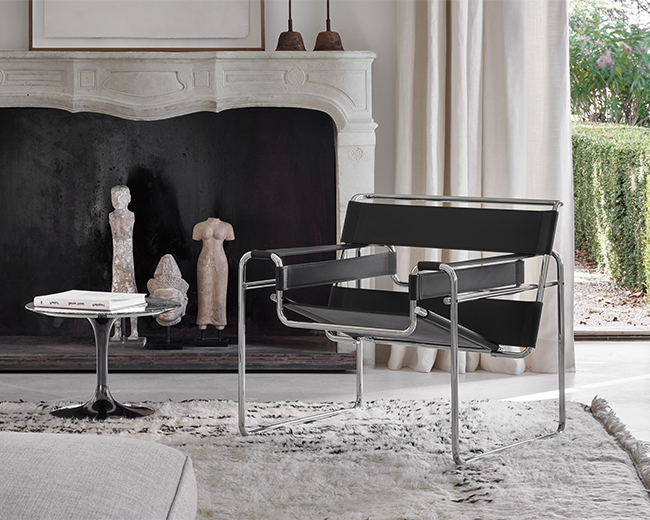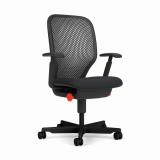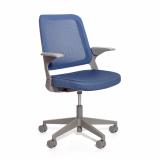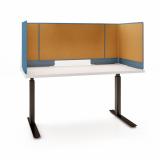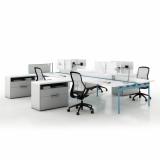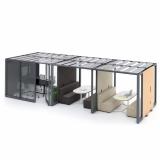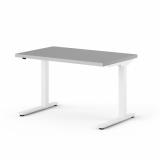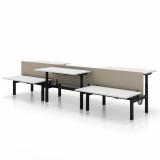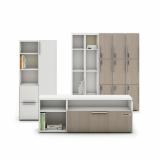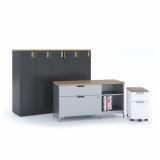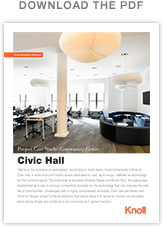
“We’re in the business of serendipity,” according to Heidi Sieck, Chief Community Officer at Civic Hall, a work-and-community space dedicated to civic technology—defined as technology for the common good. The brainchild of founders Andrew Rasiej and Micah Sifry, the space was established as a way to nurture connections focused on the technology that can improve the civic life of communities. Challenged with a highly compressed schedule, Civic Hall partnered with Knoll for design-driven furniture solutions that would allow it to serve its mission as concepts were taking shape and continue to be functional as it gained traction.
Drivers
Develop an Environment that Promotes Collaboration, Advances Ideas
As a longtime public advocate who supported the use of technology to make the world better, Andrew Rasiej noticed a growing community of people asking the same questions and trying to solve the same problems. “I saw an opportunity to create a physical place that would allow them to collaborate and work together to actually advance these from ideas in our heads to scale so they could actually touch people’s lives,” Rasiej explained.
“To create a place for collaboration,” Rasiej continued, “design really matters not only in the physical sense but also in the kinds of emotions and energies and feelings people have when they’re working together. We wanted to create an environment that would allow them to pursue their goals.” A wellappointed physical space that supported such ideals would bring Rasiej’s vision to life.
Nurture Cross-Pollination across Diverse Sectors
A central tenet of Civic Hall is to serve a highly diverse membership in an environment that nurtures idea-sharing, collaboration and cross-pollination. Linked by a functional focus on technology and an ethos to make the world a better place through technology and social innovation, Civic Hall members vary widely by sector.
“Members could be politicians, authors, entrepreneurs, academics, journalists, data scientists, ‘civic hackers,’” explained Heidi Seick, Chief Community Officer. “Not only would they come from a range of sectors, their workspaces had equally diverse origins, each with a different relationship and experience of space.
“Journalists are out and about in the world looking for stories and different issues. Academics are working in institutions. Government employees are working in civic buildings. Political activists and community organizers are campaigning out on the streets,” she explained.
“Civic Hall had to be a space where people from different sectors, with different relationships to their workspace, can be in a place that’s flexible and familiar to them, yet generates the opportunity for collaboration across these different personal and professional experiences.“
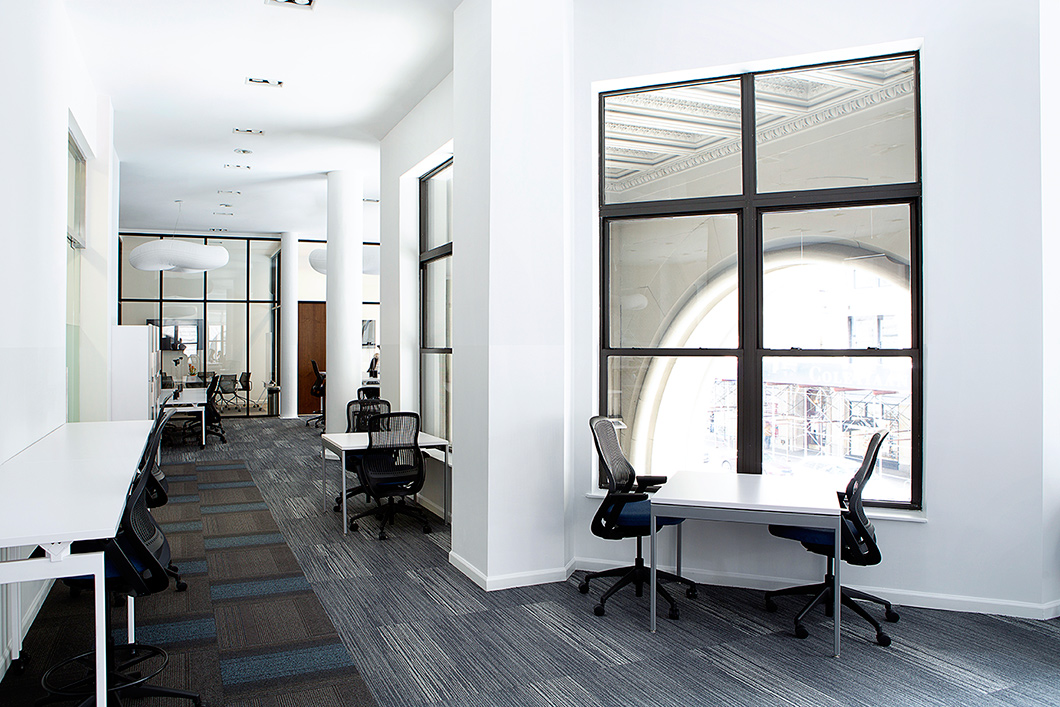
Founder Andrew Raisej felt strongly that well-designed spaces that make workers feel comfortable and valued enhance creativity, collaboration and productivity. Finding a space with high ceilings and extensive natural light that would support worker well-being became the foundation of his vision.
Featured: ReGeneration by Knoll Work and High Task Chairs, Antenna Workspaces Tables

Civic Hall was founded as a vibrant community center that provides space for collaborative work and community events for a diverse group of civic innovators to work, network, learn and organize to solve civic problems at scale.
Featured: ReGeneration by Knoll High Task Chair, k. lounge
Provide Current and Future Flexibility
As a new organization, Civic Hall could not be certain who their members would be or how they would use the day-to-day workspaces at the time of planning.
However, one steadfast organizational goal was to open up the space frequently and enthusiastically to welcome other members of the community for a range of events, presentations and conferences.
Thus, not only did the space and the furnishings need to flex and adapt for day-to-day working and collaborating, it needed to be easily configured to support various large group gatherings ranging from lectures and movies to seminars and receptions.
Produce a Cohesive, Welcoming Environment
Much like a co-working space, Civic Hall is a community where people don’t have to come to work, but rather want to come to work, explained Alana Stevens, Knoll Vice President of Marketing.
Founder Andrew Rasiej felt likewise, believing strongly that creativity, productivity and collaboration are nurtured in a beautiful environment. Understanding the positive effects natural light play in work environments, “we looked for a place that had lots of light, high ceilings, a lot of openness.”
“One of the goals is to make sure it’s cohesive and consistent and gives workers the sense they are respected by the quality of materials around them,“ he said.
Honor the Architecture
Civic Hall founders conducted an exhaustive space search before arriving at the Presbyterian Building, the ornate 19th century building that could bring their vision to life. Located in Manhattan’s Flatiron District, cradle of Silicon Alley and home to many of the city’s leading digital and advertising agencies, the circa 1894 building is an imposing presence on lower Fifth Avenue. Inspired by French Gothic chateau, the building has a striking entranceway leading to an ornate lobby and grand staircase. Up one flight is Civic Hall’s sprawling space, surrounded by large windows that bathe it in natural light and openness and provide views and a connection to the rhythms of a bustling New York City neighborhood.

Lightweight stacking chairs and modular ottomans provide maximum flex for a multipurpose space that hosts lectures, receptions, workshops and movies on near-daily regular basis. The bright palette adds a blast of energetic color.
Featured: Spark Series Side Chairs, k. lounge Stools
Tactics
Table-based Furniture System and Modular Soft Seating for Flexibility and Adaptability
A core strategy to both meet an urgent delivery schedule and support future flexibility was to leverage furniture platforms across several spaces, made possible by several Knoll “families of furniture.” Chosen for its inherent adaptability, as well as simplicity of design and color, the Knoll tablebased Antenna Workspaces system was a single furniture solution used throughout Civic Hall. Specified in focused, shared and team areas, it appears in varied applications including benching workspaces, standing tables and in enclosed offices, conference rooms, meeting rooms and the café. Casters provide added mobility and ease of reconfiguration as needs change from daytime workspace to evening community events.
A similar tactic was taken for furnishings in activity spaces. k.lounge, a modular softseating furniture collection, was specified in open areas while other Knoll pieces designed for flexibility were used in team rooms, refuge spaces and event seating.

A vestibule outside the community space frequently functions as a reception area prior to events. Lightweight high tables and tables on casters provide for easy setup.
Featured: Dividends Horizon X-Base Tables, Antenna Workspaces Tables
Comfort and Aesthetics to Cultivate Collaboration, Inspire Productivity
For Rasiej, a successful endeavor requires a focus on the design and comfort that goes beyond the physical space and extends to the products and people associated with it.
To cultivate a culture of collaboration begins with a diverse community, and is nurtured with an open, comfortable environment that encourages serendipitous encounters and furniture that allow a seamless transition from technology to interpersonal, spontaneous conversation, according to Rasiej.
“As the physical nature of offices has changed, people aren’t interested in being in an office with the door closed. They’re interested in being in a much more collaborative environment where they’re surrounded by other people and can easily move from one conversation to another,” he said.
“That’s the type of environment we try to create at Civic Hall. And the furniture that we chose gives people the impression as soon as they walk in the door that this is the place where they can collaborate with others and be connected to the technology. So they can be as productive as possible in the physical world as well as the virtual world.”
Utilize Materiality to Inform Space, Usage
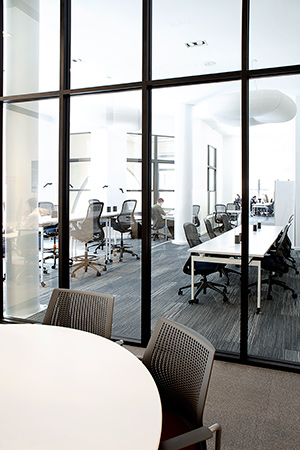
Civic Hall features a mix of open and enclosed workspaces and liberal use of glass to share the daylight that streams in from the huge windows.
To deliver a cohesive space and a productive, creative work environment that did not compete with the building’s dramatic architecture, designers opted for a neutral palette for the primary spaces.
“Working with such a powerful, beautiful building, it was a natural choice to just keep the palette very crisp,” explained designer Jessica Shaw, lead project designer at the Turett Collaborative.
“We used primarily white, and the colors – which are all quite vibrant – are used as accents.”
Workspaces feature white tables and black seating while brighter colors were used to inform usage and function.
“We knew with such a bright white space that we really wanted to tell a story through color and fabric choices,” she added. Boldly colored side chairs brighten the café and event space, complemented with ottomans in the matching palette of citron, blue and red.
In some of the enclosed workspaces rooms, task seating features same-color upholstery in spaces nicknamed “the red room,” “the green room” and so on.
One of the most whimsical uses of color pop is in the open bench seating area where six vintage phone booths, sourced on eBay and painted to match the palette, line the wall.
A Modern Interior for a Classic Building
For designer Shaw, the Flatiron District presents a bit of old New York flavor that is readily experienced with a view out Civic Hall’s large second-story windows. “But within the building is a very modern, clean, concisely organized and defined space,” she noted. “There was a lot of sourcing and research that went into putting together a space that was more eclectic, but still had a cohesive-looking design.”
Working within an historic building also drove furnishing decisions. “The modern, iconic quality of the KnollStudio pieces such as the Saarinen tables and the really clean lines of the worksurfaces were a perfect foil.”
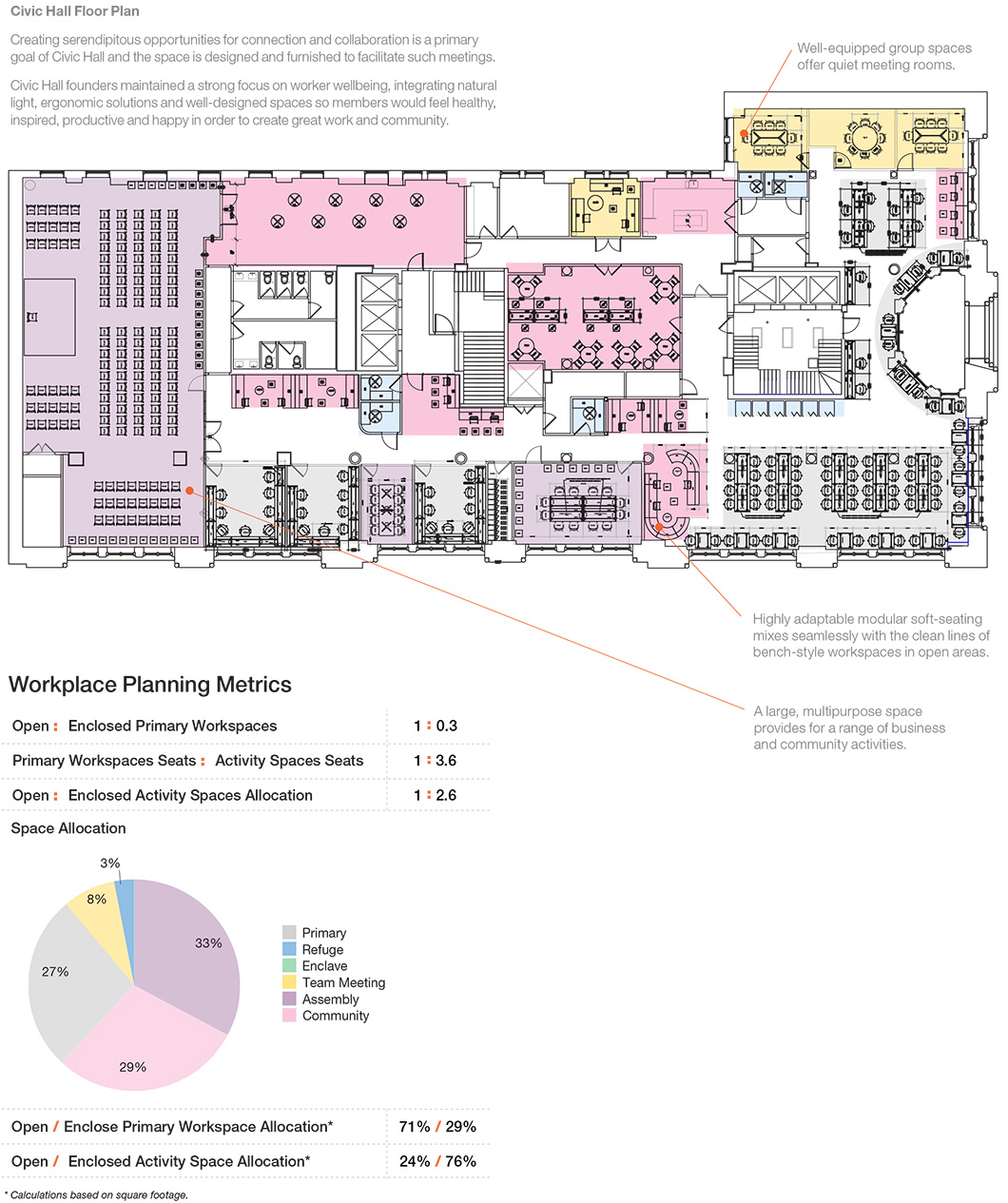
Outcome
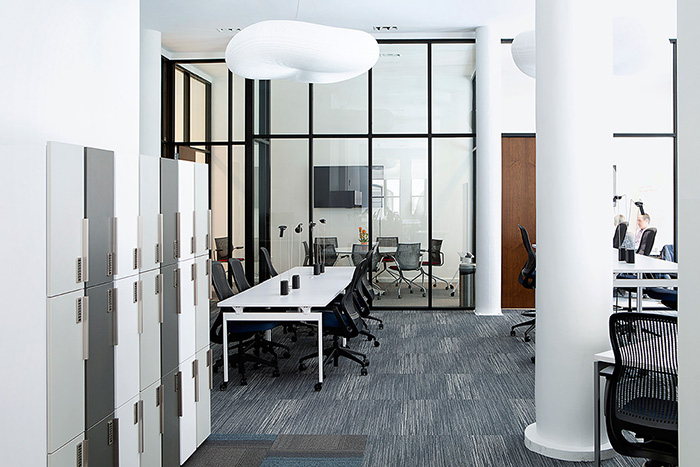
To serve a highly diverse population from sectors ranging from government to academia to journalism to politics, each of whom had a different relation to space, required a deft design touch and highly adaptable furnishings. A table-based furniture solution that adapts easily for focus and group environments is used with casters for easy mobility, and is the basis for workspaces throughout Civic Hall.
Featured: ReGeneration by Knoll Work and High Task Chairs, Antenna Workspaces Tables, Sparrow Desktop Lights, MultiGeneration by Knoll Hybird Chairs, Saarinen Oval Dining Tables
Comfort That Spans Disciplines and Sectors
While a recent member survey quantified that a majority of members find the space aesthetically pleasing and encourages productivity and collaboration, Civic Hall founders feel equally satisfied and confident they met their goal of an inspiring setting. “We believe we’ve created an environment here that is beautiful, functional, visually pleasing and open. No matter where you come from, what your work experience is, or what your relationship to civic technology is, you feel very comfortable here. It feels like a place where you can collaborate with likeminded individuals who come from a different sector,” explained Sieck.
“We have a beautiful open community space that has gorgeous desks and comfortable chairs and lots of light. People can work productively yet can interact with their friends and their colleagues and create serendipities every moment that they’re here,” she added.
“People are using the space exactly the way we intended which is that the furniture is a partner with them,” agreed Rasiej. “It allows them to be flexible, to be comfortable, to feel productive, to feel respected.”
“It’s filled with furniture that allows them to pursue their goals and projects in a transparent way. It sends a message to them that they have everything around them in order to achieve what they’re trying to achieve,“ he added.
Furniture and Functionality Befitting an Evolving Organization
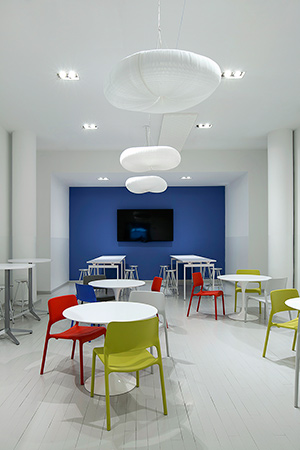
Varied table and seating options in the café support snacking, socializing, working and informal meeting. Bright, versatile chairs add a dose of vibrant color.
Featured: Saarinen Round Dining Tables, Spark Side Chairs, Dividends Horizon X-Base Tables, Antenna Workspaces Tables, Twist Barstools
As with any young entity, Civic Hall is constantly reevaluating its operation. When a need for a chief community officer position was identified, founding COO Heidi Sieck took on the job, and attorney-turned-consultant Jessica Goldfarb assumed the COO title and a full-time role. In the same way, Civic Hall has been relocating and reconfiguring furniture as needs evolve. “We found the café was being underutilized,” recalled COO Goldfarb. Unlike many new workspaces, where meetings and remote working take place as often in lunch rooms and lounges as conference rooms, “people were only eating their lunch and going back to their desks,” she noted. By swapping lounge pieces from the reception area with tall tables in the café, Civic Hall created an even more relaxed setting for meals and discourse. Members are now frequently spotted on their phones, laptops or lingering in conversation in the cafés new lounge area.
Serendipitous Meetings that Lead to Real-life Solutions
In addition to being in the business of connection and collaboration, Civic Hall strives to be a place where ideas can come to life and projects can happen, according to Sieck.
“We’re seeing people come together in ways that they never have before, in ways that they can solve these problems and share with each other in a way that’s supportive and delightful,” she said.
Despite its short existence, any Civic Hall staff can recall numerous incidents of connections made at the community space that are leading to real-life solutions. From the New Jersey mayor who sought to encourage women to run for office who was introduced to a member whose organization did that very thing, to a casual conversation about the difficulties of public transportation for wheelchair-bound individuals in the city that led to exploration of a technology-based solution (“Uber-ize” it), connections happen at Civic Hall.
Serendipitous encounters occur in the community space as well as science fairs, lectures, panels, training sessions and movie nights.
“We’re also in the business of advancing ideas and that really happens in our gorgeous event space which is either used for Civic Hall purposes or available to the general public for events,” related Sieck. “It’s this wonderful place where people can learn and grow,” she added.
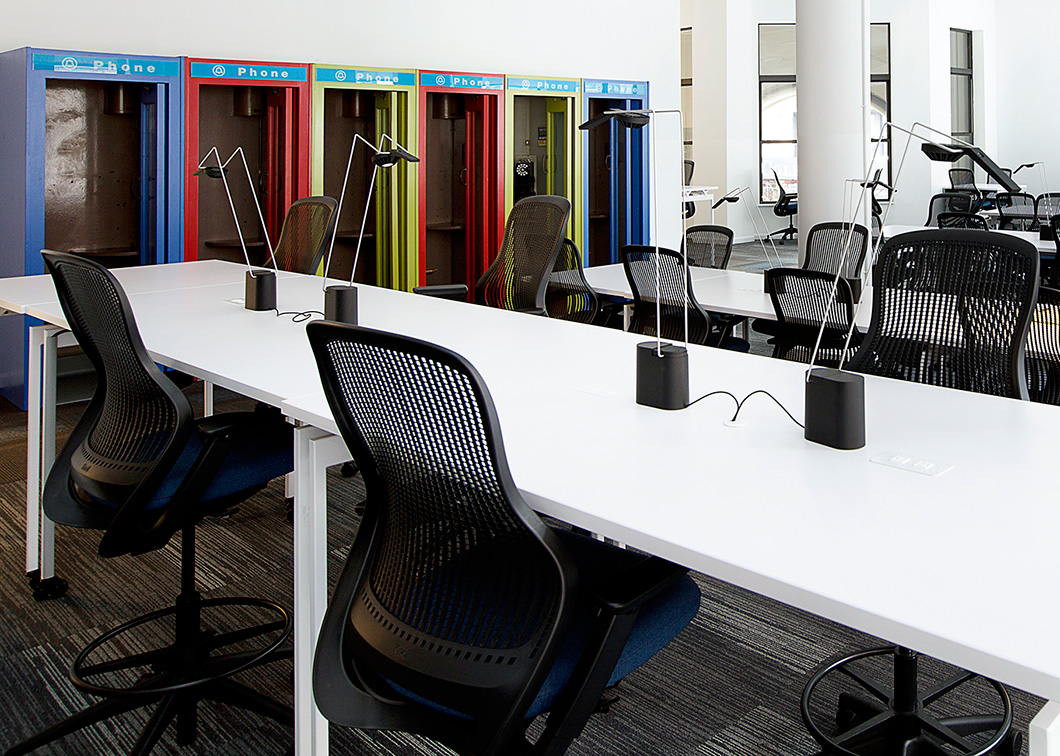
An open area with bench-style workstations, in both standard and standing height, is the core of the Civic Hall open workspace. Bright white tabletops enhance the spacious feeling experienced with the building’s open layout, white walls, high ceilings and generous natural daylight. Desk-lamps imply a focused workspace, while bursts of bright color highlight activity spaces.
Featured: ReGeneration by Knoll Work and High Task Chairs, Antenna Workspace Tables, Sparrow Desktop Lights
One Stop Shopping for Expediency, Cohesiveness
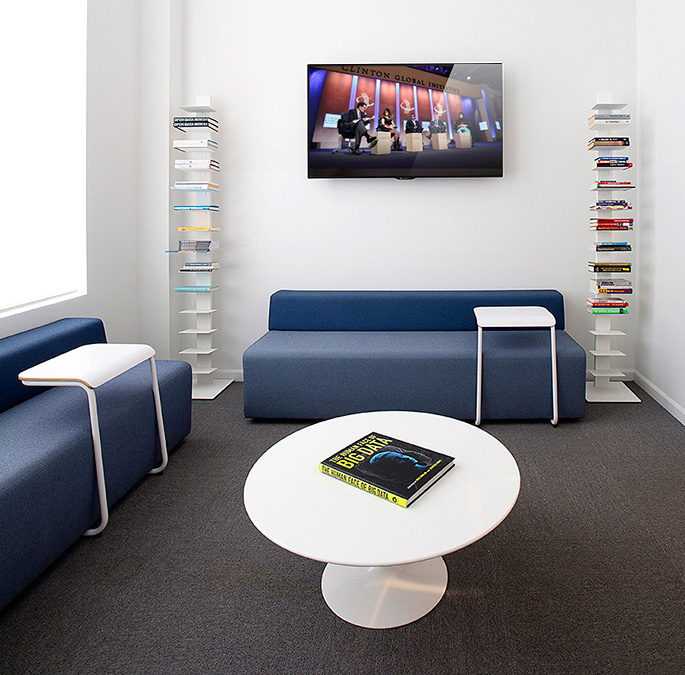
Civic Hall’s library provides an informal meeting area or another choice of workspace.
Featured: k. lounge Collection, Toboggan Pull Up Tables, Saarinen Coffee Table
To meet its tight time frame, Civic Hall sought a single vendor capable of supplying virtually all elements needed to furnish its space.
Therefore, it was critical that the selected manufacturer be able to satisfy all its needs, even those Civic Hall didn’t know existed, such as the standing height table desks that became a “must-have” once founder Andrew Rasiej was presented them.
“We knew once we saw the Knoll options that we were going to go with system-based furniture,” recalled designer Jessica Shaw.
“Knoll was tremendous at making what was almost the impossible happen,” she recalled. Working closely with the design team, Knoll, and dealer partner Offices Limited Inc., steered people and processes as needed to assure availability and delivery of all furniture.
Furniture that Drives Design and Vice Versa
With such great architectural “bones” to work with, Civic Hall founders were eager to allow the furniture to drive the design. “The architecture of the space really spoke to the very specific needs Andrew had in mind,” recalled Shaw, who has collaborated with Rasiej for more than a decade.
“We felt that if we started with a really great space with light and air you wouldn’t really need a lot of design around the architecture,” said Rasiej. “What you do need is really great furniture to animate the space.”
“At Civic Hall, what comes through in the design is the quality of the furniture, not the quality of the architecture. So the furniture actually is the design of Civic Hall,” he added.
Knoll was a more-than-willing partner. “When we met Andrew, I immediately understood that he believed, as Knoll does, in great design. And he understood as he was setting out on this mission to create a space and community for people who were going to create great impact for the world that there was a real power in design to inspire them to do their best work,” explained Alana Stevens with Knoll.
“Everyone who walks through the door is absolutely delighted by the space: its expansiveness, its light and its beautiful clean design,” agreed Sieck.
“I like to say that every day when we open the door the world changes.”
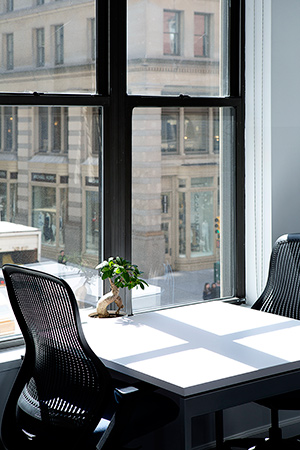
Situated in New York City’s Flatiron District, the heart of Silicon Alley, Civic Hall occupies the second floor of an ornate 19th century building. Large windows integrate the city flavor one flight down.
Featured: ReGeneration by Knoll Work Chairs, Antenna Workspaces Tables
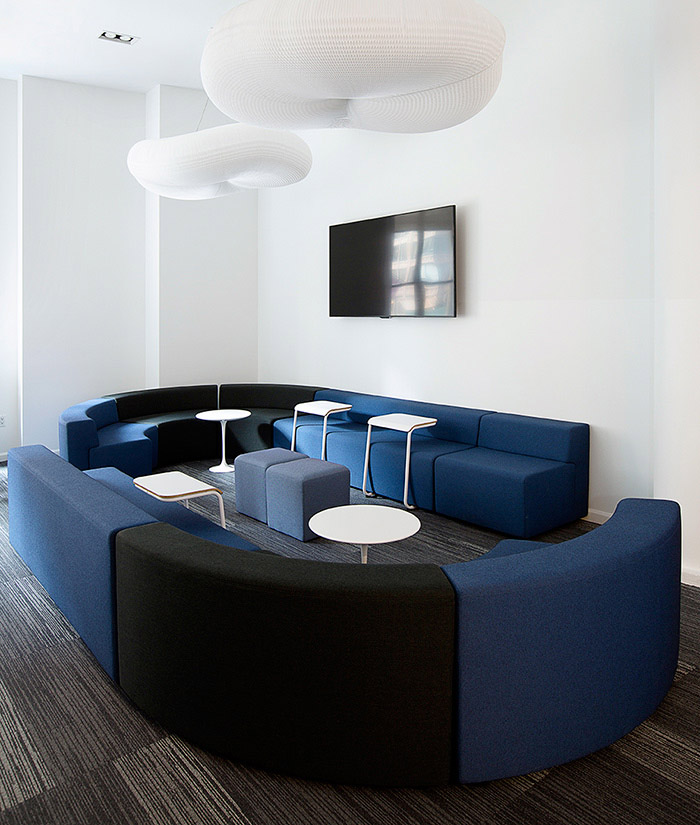
Modular soft-seating defines activity spaces throughout Civic Hall and is easily reconfigured as needs change. Pull-up tables provide an added worksurface in lounge areas and can double as casual seating as well.
Featured: k. Lounge Collection, Toboggan Pull Up Tables, Saarinen Side Tables
• • •
Civic Hall
Awards
• Global Innovators Award Finalist from CoreNet Global
• 2014 IIDA Calibre Award
Client Profile
Civic Hall, a project of Personal Democracy Media, is a vibrant year-round community center, collaborative work and event space in the heart of New York City’s Silicon Alley, where a diverse group of civic innovators work, network, learn and organize to tackle and solve civic problems at scale. Its growing community of technologists, social entrepreneurs, government officials, organizers, philanthropy professionals, journalists, researchers and makers are dedicated to cutting-edge problem-solving.
Project Team
Knoll, Inc.: Knoll New York
Knoll Furniture Dealer: Offices Limited Inc., New York, NY
Architectural and Design Firm: The Turett Collaborative
Download "Civic Hall" to Read the Full Case Study




